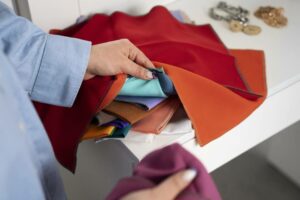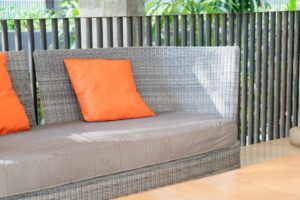Despite the expansive variations of textiles, few materials evoke the same level of luxury and sophistication as leather fabric.
Whether gracing the interiors of high-end vehicles or adorning fashion accessories, leather has long been revered for its timeless appeal.
However, consumer preferences are evolving, and environmental concerns are rising. As a result, the leather industry has witnessed the emergence of innovative alternatives such as faux and vegan leather fabrics.
Let’s explore the intricate differences between real, faux, and vegan leather fabrics so you can decide which option aligns with your values, preferences, and business requirements the best.
What is Real Leather Fabric?

Real leather comes from animal hides or skins, such as cattle, sheep, or goats. The tanning process preserves and softens the hide, creating a durable and supple material.
A defining characteristic of real leather is its unmatched durability and breathability. When properly cared for, real leather can develop unique staining over time, adding depth to its appearance.
This rich texture and luxurious feel have made it a premium choice for high-end products, from designer handbags to upscale furniture.
However, the use of real leather raises ethical concerns due to its reliance on animal byproducts.
Additionally, tanning leather involves chemicals and significant water usage, which affects the environment.
Nevertheless, the leather industry is exploring sustainable practices such as vegetable tanning and waste reduction to tackle this issue.
Read More: Outdoor Furniture: Upholstery to Withstand the Elements
What is Faux Leather Fabric?

Faux leather, also known as pleather or polyurethane (PU) leather, is a synthetic alternative to real leather.
Typically made from polyvinyl chloride (PVC) or polyurethane, combined with various additives and coatings, faux leather offers a cost-effective and more accessible option.
One of the primary advantages of faux leather is its affordability and consistent quality, making it a popular choice for various applications, including:
- Upholstery
- Fashion accessories
- Automotive interiors
Additionally, faux leather is water-resistant and easy to maintain, further contributing to its widespread appeal.
However, compared to real leather, faux leather generally has a shorter lifespan and lacks the breathability that natural materials provide.
Furthermore, the production of faux leather can affect the environment due to the use of non-biodegradable plastics and chemicals.
It’s important to note that different types of faux leather, such as PVC and PU, have varying levels of quality and environmental impact.
What is Vegan Leather Fabric?

Lastly, vegan leather fabric represents a cruelty-free and eco-friendly alternative to both real and faux leather.
This innovative material is produced by processing various plant-based materials, such as pineapple leaves, mushrooms, cork, or recycled materials.
Vegan leather has the potential for carbon negativity. This is because the plant-based materials used in their production absorb carbon dioxide during their growth phase.
Additionally, vegan leather offers breathability, appealing to consumers who prioritise ethical and sustainable practices while avoiding the use of animal products.
While vegan leather is an environmentally conscious choice, its durability is often limited compared to real leather.
Furthermore, vegan leather may still require chemical treatments and its texture, appearance, and performance characteristics can vary depending on the plant-based materials used.
However, efforts are being made to develop more sustainable production methods.
Read More: Acrylic Fabric for Upholstery: What You Must Know
How to Choose the Right Leather Fabric
Ultimately, selecting the appropriate leather fabric involves considering a variety of factors, including durability, ethics, and environmental impact.
When choosing the material for a leather product, it’s important to consider its intended use and application. This will ensure that the material meets the necessary performance requirements.
For businesses, choosing the right leather fabric that aligns with brand values and target audience preferences is important for brand consistency. In some cases, combining different leather types may be necessary to achieve specific goals.
Kintex’s Premium Leather Fabric for Premium Products
As a leading PU and PVC leather supplier, we want to provide only the best leather fabric options in the industry. You can find a variety of textures, colours, and finishes in one place: our PU and PVC leather collections.
We also prioritise sustainability by continuously exploring eco-friendly alternatives and adopting responsible manufacturing practices.
By partnering with Kintex, you can confidently select the leather fabric that not only meets your functional requirements but also aligns with your brand’s values and commitment to environmental stewardship.







